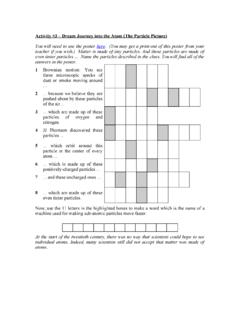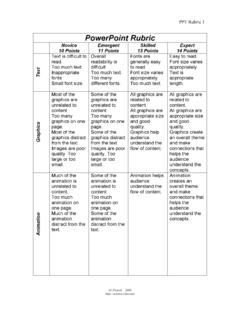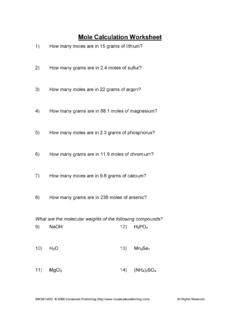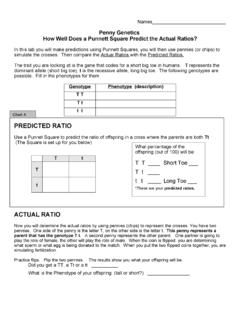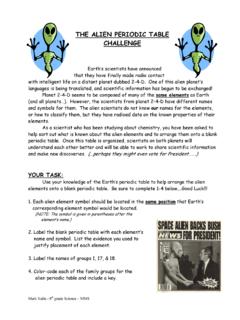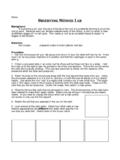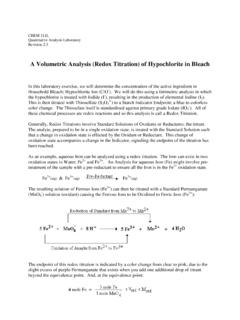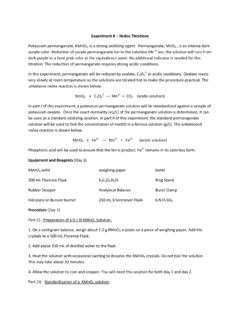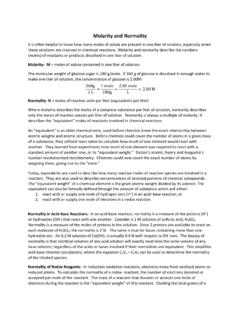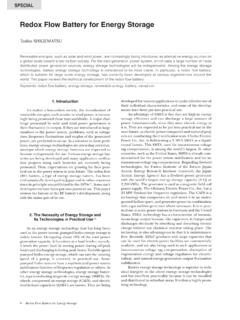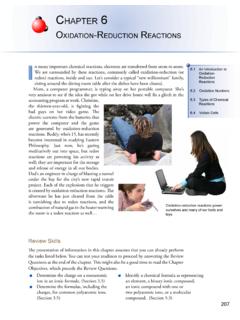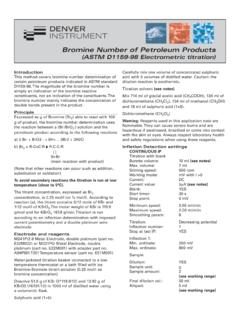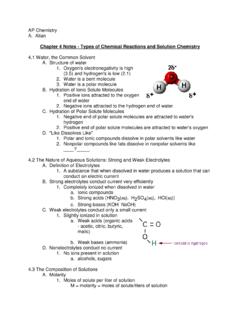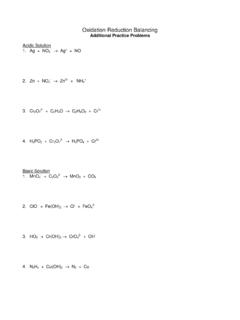Transcription of A Holiday Redox Activity
1 Publication No. 10222 Ornament-MakingA Holiday Redox ActivityIntroductionHoliday fun combine chemistry and art to design a Holiday ornament!Chemical Concepts Redox reactions Metal reactivityMaterialsAcidified copper(II) nitrate solution, Cu(NO3)2, M, 25 mL Ornament hangerGalvanized (zinc-coated) iron, 2 2 piece Masking tapeHydrochloric acid solution, HCl, 6 M, 50 mL Paper towelsBeaker, 150-mL PencilBeaker, 1-L ScalpelCotton swab TongsEraser Acrylic sealer (optional)Graduated cylinder, 50-mLSafety PrecautionsHydrochloric acid solution is corrosive to skin and eyes and is moderately toxic by ingestion and inhalation. Acidified copper(II) nitrate solution is slightly toxic by ingestion and is a skin, eye, and mucous membrane irritant. The edges of the galvanized iron are sharp be careful to avoid cuts and scratches. Wear chemical splash goggles, chemical-resistant gloves, and a chemical-resistant apron.
2 Please review current Material Safety Data Sheet for additional safety, handling, and disposal 1. Galvanized iron can be found at hardware stores it is usually sold in large sheets. Cut into 2 2 squares using tin snips. Bore holes large enough to accept an ornament hanger into the pieces using either a drill or a drill press. 2. Prepare 250 mL of acidified copper(II) nitrate solution by dissolving 3 grams of copper(II) nitrate trihydrate, Cu(NO3)2 3H2O, in 250 mL of a M hydrochloric acid 1. Completely cover both sides of a 2 2 piece of galvanized iron with masking tape. Mark where the hole is this is the top of the ornament. Make sure that the edges of the galvanized iron are also covered. 2. Draw a simple design (such as your initials or name) on the masking tape with a pencil. Designs may be drawn on both sides of the piece of galva-nized iron if desired.
3 The design that is drawn will become the copper-colored part of the ornament. See Figure 1. 3. Use a scalpel to cut along the pencil marks. Remove the masking tape inside the drawing only so that the design is uncovered. See Figure AreaTaped AreaFigure ..makes science teaching easier. 2012, Flinn Scientific, Inc. All Rights Reserved. Reproduced for one-time use with permission from Flinn Scientific, Inc. Batavia, Illinois, No part of this material may be reproduced or transmitted in any form or by any means, electronic or mechanical, including, but not limited to photocopy, recording, or any information storage and retrieval system, without permission in writing from Flinn Scientific, Inc. 2 2006 Flinn Scientific, Inc. All Rights Reserved. 10222 4. Pour about 50 mL of 6 M hydrochloric acid solution into a 1-L beaker. Submerge the ornament in the hydrochloric acid solution using a pair of tongs.
4 Lay the ornament flat on the bottom of the beaker so that it is completely submerged. 5. As soon as the rapid bubbling stops, remove the ornament from the hydrochloric acid solution using the tongs. Rinse the ornament with tap water and dry it with a paper towel. 6. Carefully clean the exposed area of the design by rubbing it with an eraser. Do not remove the masking tape. 7. Pour about 25 mL of copper(II) nitrate solution into a 150-mL beaker. Dip a cotton swab into the acidified copper(II) nitrate solution and gently rub the solution over the exposed parts of the design. 8. Once the entire design area is coated with copper, rinse the ornament with tap water and dry it with a paper towel. Remove the masking tape from both sides of the piece of iron. Attach a hanger to the hole in the top of the ornament. 9. (Optional) Coat both sides of the ornament with acrylic sealer. Hang the ornament so that it can dry consult your current Flinn Scientific Catalog/Reference Manual for general guidelines and specific procedures gov-erning the disposal of laboratory waste.
5 Neutralize and dispose of the hydrochloric acid solution according to Flinn Suggested Disposal Method #24b. Dispose of the acidified copper(II) nitrate solution down the drain according to Flinn Suggested Disposal Method # Explain to students that the places where the tape is removed will be the portion of the ornament that becomes copper- colored. Make sure that they design their ornaments accordingly. Suggest that the students keep the designs relatively simple, as simple designs tend to turn out best. Different designs can be drawn on each side of the ornament if desired. Make sure students note where the hole is located so that they orient their designs correctly. If they happen to prepare the ornament upside down or sideways, a new hole can be drilled in the top. Acrylic sealer may be applied to the ornaments to slow the tarnishing of the copper. Apply the acrylic sealer evenly to both sides of the ornament.
6 Hang the ornaments in the laboratory and allow the sealer to dry iron is iron coated with a layer of zinc. The zinc protects the iron from rusting. The zinc layer is removed by sub-merging the galvanized iron in hydrochloric acid. The reaction between zinc and hydrochloric acid generates lots of bubbles from the formation of hydrogen (s) + 2 HCl(aq) Times Size 10 ZnCl2(aq) + H2(g)Once the zinc layer is removed, the iron surface then reacts with copper(II) nitrate. As the reaction occurs, a thin layer of cop-per metal is plated onto the surface of the (s) + Cu(NO3)2(aq) Times Size 10 Fe(NO3)2(aq) + Cu(s)In the design areas where the zinc layer has been removed, the underlying iron reacts with copper(II) ions, depositing cop-per on the surface and changing the color of the design area to reddish-orange. In areas where the galvanized iron does not undergo reaction with HCl, the ornament retains its original silver to the National StandardsThis laboratory Activity relates to the following National Science Education Standards (1996):Unifying Concepts and Processes: Grades K 12 Constancy, change, and measurementContent Standards: Grades 9 12 Content Standard B: Physical Science, structure and properties of matter, chemical reactionsReferenceFun with Chemistry; Institute for Chemical Education, University of Wisconsin Madison, Ornament-Making Activity is available as a student laboratory kit from Flinn Scientific, KitConsult your Flinn Scientific Catalog/Reference Manual for current prices.
7 2012, Flinn Scientific, Inc. All Rights Reserved. Reproduced for one-time use with permission from Flinn Scientific, Inc. Batavia, Illinois, No part of this material may be reproduced or transmitted in any form or by any means, electronic or mechanical, including, but not limited to photocopy, recording, or any information storage and retrieval system, without permission in writing from Flinn Scientific, Inc.
